Infulence of Current Density on the Photocatalytic Activity of Nd:TiO2Coatings
SHI Yuanji, ZHANG Zhen, DAI Yunzhong, LI Jingxiao, CHEN Zeyu
(1.School of Mechanical Engineering, Nanjing Vocational University of Industry Technology, Nanjing 210046, China; 2.College of Material Science and Technology, Nanjing University of Aeronautics and Astronautics, Nanjing 210016, China; 3.School of Materials Science and Engineering, Nanjing Institute of Technology, Nanjing 211167, China; 4.Key Laboratory of Modern Agricultural Equipment and Technology,Jiangsu University, Zhenjiang 212013, China)
Abstract: The Nd:TiO2 PEO coatings were formed in a phosphate-based electrolyte with the addition of Nd2O3 under the current density of 150, 200, 250 and 300 mA/cm2.SEM results showed that the micropores decreased on quantity and increased on scale with the increasing current density.AFM results revealed that the roughness of the coatings increased with the increasing current density.Phase and composition analysis showed that the Nd:TiO2 coatings were mainly composed of anatase and rutile phase.And the anatase phase content has reached the maximum value at the current density of 250 mA/cm2.XPS results indicated that Ti2p spin-orbit components of the Nd:TiO2 coatings are shifted towards higher binding energy, compared with the pure TiO2 coating, suggesting that some of the Nd3+ ions are combined with TiO2 lattice and led to dislocation.Photocatalytic test showed that the photocatalytic activity of Nd:TiO2 coatings varied in the same pattern with the anatase content variation in Nd:TiO2 coatings.The photocatalytic experiment results show that the photocatalytic activity of Nd:TiO2 coatings can be greatly enhanced with moderate amount of Nd3+.However,excessive amount of Nd3+ does not have an effective impact on the photoctalytic activity improvement.
Key words: PEO; current density; AFM; XPS; Nd:TiO2; photocatalytic
1 Introduction
Plasma electrolytic oxidation (PEO), derived from the anodic oxidation, has been popular since the year of 2000.From common view, PEO seems to be the most effective surface modification technique that can produce better ceramic coating with good corrosion resistance and wear resistance on valve metals (aluminum, magnesium and titanium) and their alloys[1-4].According to the previous references, the properties of PEO coatings can be affected by many factors, such as electrical parameters[5-7], concentration of the electrolyte[8,9], additives[10-12].On the other hand, the PEO technology can be applied into many fields, like corrosion protection[10], tribological[3],photocatalytic[13,14].The PEO process is carried out under extremely high voltages.First, there emerges some bubbles on the specimen, then, some scattered sparks appear.With the treatment continues, more and more sparks appear on the surface of the specimen.In the end, the PEO coatings with great corrosion insensitivity and mechanical properties were fabricated on the surface of specimen.
With the economic development, the pollution of our environment has been paid more and more attentions.Methylene blue (MB), the common dyes,has been widely used in coloring cotton, paper stock and some similar fields.Some workmen usually exposed to MB with some simple protection will cause tissue necrosis, shock, vomiting and other disease[15,16].
As far as we known, titanium dioxide (TiO2), one of the commonest semiconductor materials has been widely used as an efficient photocatalyst because of its high photocatalytic activity[16].On the other hand, it can be easily made by PEO treatment[17].In this study,the main objective is to investigate the enhancement photocatalytic activity of Nd:TiO2coatings compared to the pure TiO2coatings.The suitable PEO treatment voltage was investigated.The surface morphology and composition of coatings were charaterized by scanning electron microscopy (SEM), X-ray diffraction (XRD),X-ray photoelectron spectroscopy (XPS) and energydispersive X-ray spectroscopy (EDS), respectively.
2 Experimental
The substrate material used in this study is pure grade Ⅱ titanium.The specimen was cut into 25 mm ×20 mm × 2 mm small samples.Then, these specimens were ground with 200, 500, 800 and 1 200 grit abrasive waterproof paper.After that, they were cleaned in ethanol to remove the grease and other pollutants.Then,they were cleaned in deionized water and dried in ambient air.The PEO device consists of a pulse 30 kW bipolar power supply made by Xian Juncheng Precision Technology Co.Ltd.A 316L stainless steel barrel was used as the electrolyte container, and a cooling system and a stirring system were used to keep the temperature below 30 ℃.The schematic diagram is showed in Fig.1.
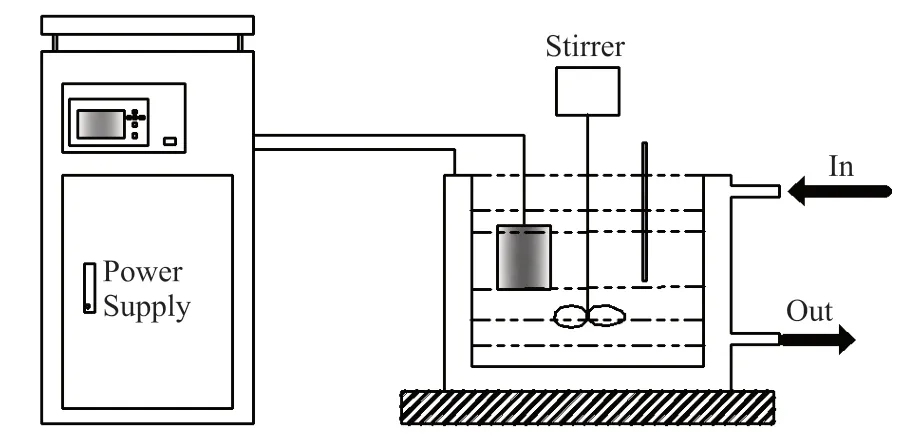
Fig.1 Schematic diagram of the PEO experimental device
The electrolyte was composed of sodium phosphate (Na3PO4, 12 g/L) with neodymium oxide (Nd2O3,10 g/L).Prior to PEO treatment, the sample was screwed through the hole of the sample center by a thin aluminum rod and suspended in the electrolyte.The samples were treated in the electrolyte with the current density of 100, 150, 200, 250, and 300 mA/cm2,to investigate the most suitable voltage for PEO on photocatalytic activity.The treatment time is 20 min for each sample.After PEO treatment, all the samples were cleaned in deionized water and dried in ambient air.
The morphology of Nd:TiO2coatings formed under different voltages were observed by scanning electron microscopy (SEM, JSM-6360LA).Before morphology observation, the coatings were first sputtered with a thin layer of Au.On the other hand, the AFM was applied to observe the top view images of the coatings.The average roughness of the coatings were measured by roughness measuring instrument.X-ray diffraction (XRD, Rigaku D/max-2500) was used to detect the composition of coatings with Cu Kα radiation between 2θvalues of 5° and 80° with a step length of 0.02° at a scanning rate of 1°/min.The Nd:TiO2coatings were examined by SEM equipped with an energy dispersive X-ray spectroscopy (EDS).X-ray photoelectron spectroscopy (XPS, Thermo escalab 250Xi)was with an Al Kα radiation (λ=1 486.6 eV).The XPS analysis was conducted after the surface of the films was etched for 1 min by argon-ion-beam to reduce the carbon contamination.All energy values were corrected according to the adventitious C 1s signal, which was set at 284.6 eV, as the reference.
The photocatalytic activity of Nd:TiO2coatings were evaluated by photocatalytic decolorization of methylene blue (MB) solution under the simulated sunlight irradiation.A 300 W high-voltage mercury lamp was used as the light source.Stand-off distance is 10 cm.The UV wavelength of the light is 365 nm.Power density is 30 W/cm on the sample surface.The photocatalytic tests were carried out in a bottle with capacity of 250 mL.The aqueous solution is MB dyes with concentration of 15 mg/L.The photocatalysts are Nd:TiO2coatings.The aqueous suspensions containing MB with photocatalyst were stirred for 40 min in dark to reach an adsorption-desorption equilibrium continuously before irradiation.Then, the mixture was exposed to visible irradiation using high-voltage lamp.The decolorization rates of MB were monitored by measuring the absorbance of MB solution atλ=665 nm using a UV 720 spectrophotometer.The decolorization efficiency was calculated as following:
wherec0is the initial concentration of MB;ctis a instantaneous concentration of MB after photoirradiation by simulated sunlight.To ensure the accuracy of the photocatalytic activity, three samples were tested for the average value.The standard deviation was within 5%.
3 Results and discussion
3.1 Morphology
Fig.2 shows the surface morphology of Nd:TiO2coatings produced in phosphate-main electrolyte with the addition of Nd2O3at the current density of 150,200, 250, and 300 mA/cm2.Clearly, the micropores decreased on quantity and increased on scale with the increasing current density (Figs.2(a)-2(d)).With the current density increasing, the PEO react become more and more fierce.Some of the micropores linked together and the bigger pores formed.On the other hand, it is showed that the roughness of the coatings surface increased with the increment of the applied current density.Especially at the current density of 300 mA/cm2, there exists some raised part on its surface(Fig.2(d)).During the PEO process, the melted parts quenched quickly with the reaction.Thus, some chilled parts accumulated around the pores and become the raised parts.
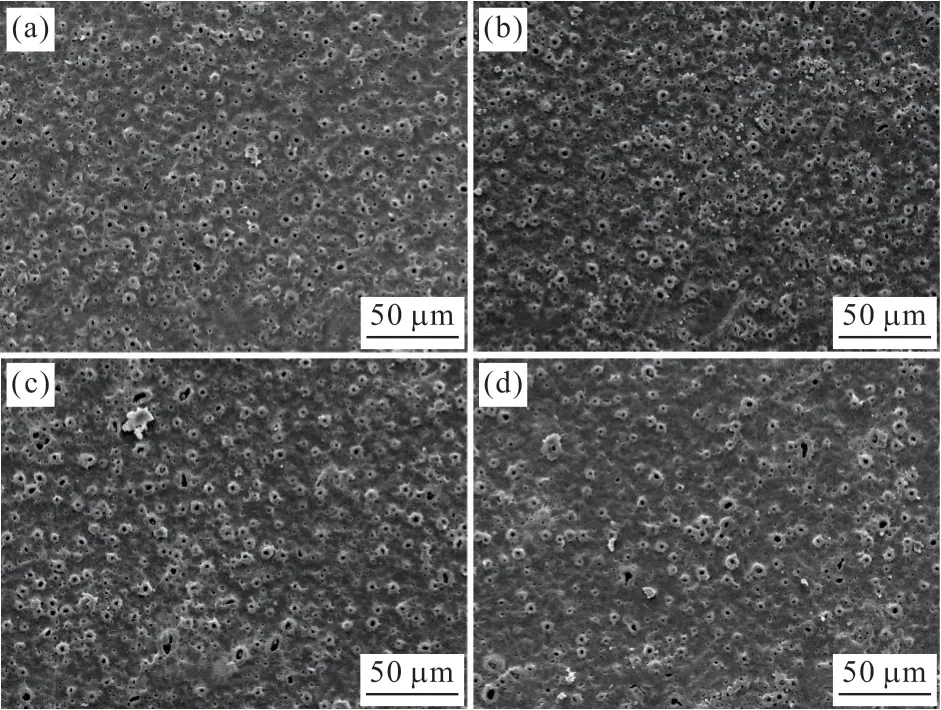
Fig.2 Surface morphology of PEO treated Nd:TiO2 coatings formed on pure titanium with electrical parameter current density: (a)150 mA/cm2; (b) 200 mA/cm2; (c) 250 mA/cm2; (d) 300 mA/cm2
The top view images of PEO treated Nd:TiO2coatings formed on pure titanium with current density of 150, 200, 250, and 300 mA/cm2are observed by AFM(Fig.3).From the data on the top right of the figure, it can be seen that the |Z| value increased with the increasing current density, which means that distance of the highest point and the lowest point increased with the increment of the current density.The |Z| value has reflected the roughness of the PEO coatings on some extent.On the other hand,the roughness measuring instrument was applied to evaluate the surface roughness of the coatings.The corresponding surface roughness of the coatings that produced under the current density of 150, 200, 250,and 300 mA/cm2is 1.026, 1.214, 1.478, and 1.749 μm,respectively, which are well matched with the |Z| value.

Fig.3 Top view AFM images of PEO treated Nd:TiO2 coatings formed on pure titanium with current density: (a) 150 mA/cm2; (b) 200 mA/cm2; (c) 250mA/cm2; (d) 300 mA/cm2
3.2 Phase and composition analysis
Fig.4 presents the XRD patterns of Nd:TiO2coatings fabricated by PEO technology under the current density of 150, 200, 250 and 300 mA/cm2.It can be known that the coatings were mainly composed of anatase phase and rutile phase TiO2(Fig.4(a)).Besides, the peaks that corresponding to titanium substrate is extremely strong due to the too slim coatings formed on the substrate.The X-ray is of ability to penetrate into the coatings and reach the titanium substrate (Fig.4(a)).On the other hand, there exists some variation on the content of anatase phase.The content of anatase first increased and then decreased(Fig.4(b)).The current density was first set at 150 mA/cm2, and some of the anatase phase was formed.With the current density increasing, the heat during the PEO reaction increased, and the content of anatase phase increased till the current density of 250 mA/cm2.With the current density continually increasing, some of the anatase phase transformed into rutile phase because of the better thermal stability of rutile phase.Thus,the content of the anatase phase decreased under the current density of 300 mA/cm2(Fig.4(b)).

Fig.4 X-ray diffraction patterns of (a) PEO treated Nd:TiO2 coatings under different current density and (b) small angel analysis
To make detailed investigation, XPS was applied to study the chemical composition of Nd:TiO2coatings and valence state of Nd in the coatings.The pure TiO2coating was performed in the phosphate-based electrolyte without the addition of Nd2O3with the current density of 150 mA/cm2.XPS spectra of pure TiO2and Nd:TiO2coating are showed in Fig.5(a).It is showed that the spectra show peaks originating from Na 1s, O 1s, Ti 2p, C 1s, P 2p and Nd 4p.In Fig.5(b),It is showed that the spin-orbit components (2p1/2and 2p3/2) are located at 464.31 and 458.38 eV, respectively,which can be assigned to Ti4+ions in TiO2coating.On the other hand, the spin-orbit components (2p1/2and 2p3/2) of the Nd:TiO2coating are shifted towards higher binding energies by 0.28 eV approximately (Fig.5(b)).The results is owing to the lattice distortion.During the PEO reaction, the intermediate oxidation state of Ti is not stable, and the Nd3+is of ability to infiltrate into the TiO2lattice.

Fig.5 (a) XPS spectra and (b) high-resolution Ti 2p XPS spectra of pure TiO2 and Nd:TiO2 coatings produced by PEO method under the current density of 150 mA/cm2
3.3 Photocatalytic evaluation
The photocatalytic decolorization percentage of pure TiO2coating (blank) and Nd:TiO2coatings were characterized by photocatalytic irradiation in MB solution after different time interval, as presented in Fig.6.It is clearly seen that the photocatalytic decolorization percentage of all Nd:TiO2coatings are increased with the increasing irradiation time in MB solution.This indicated that the photocatalytic reaction were continuous during this irradiation time.On the other hand, during the whole 180 min, the photocatalytic decolorization percentage of the Nd:TiO2coating formed under the current density of 250 mA/cm2is higher than that of all the other coatings in every irradiation time interval.This results directly proved that the coating formed under the current density of 250 mA/cm2is of the highest photocatalytic activity among these coatings.From another viewpoint, it can be seen that the pure TiO2coating without Nd2O3was of the most inferior photocatalytic decolorization percentage compared with the Nd:TiO2coatings (Fig.6).And it is also found that the blank one was only of 15.5 %photocatalytic decolorization percentage after 180 min irradiation.However, with the addition of Nd2O3, the photocatalytic decolorization percentage of Nd:TiO2coating processed with current density of 150 mA/cm2was of 35.6 % after 180 min irradiation.And according to the previous research[16], it can be concluded that the anatase content can greatly affect the photocatalytic activity of TiO2coatings.It is showed that the anatase content increased to the maximum value at the current density of 250 mA/cm2(Fig.4(b)).Therefore, in our study, it is also indicated that the anatase is of ability to have an effect on the Nd:TiO2coatings.
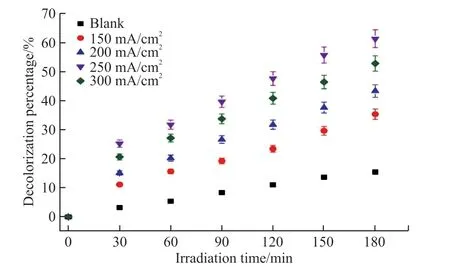
Fig.6 Photocatalytic decolorization percentage of pure TiO2 coating(blank) and Nd:TiO2 PEO coatings formed under the current density of 150, 200, 250, and 300 mA/cm2 in MB solution after different time of simulated sunlight irradiation
According to the former cognition, oxide Nd2O3itself is not of photocatalytic activity.However, TiO2is of relatively high photocatalytic activity.While the TiO2coating was combined with Nd2O3, the photocatalytic activity was greatly enhanced.The great improvement was mainly owing to the incorporation of Nd3+.Fig.7 was used to compare the photocatalytic activity of Nd:TiO2coatings and pure TiO2coatings after different PEO treatment time.From the figure, it can be clearly seen that the photocatalytic decolorization percentage of Nd:TiO2coatings increased first and then decreased with the PEO treatment time after 180 min irradiation.At the treatment time of 20 min, its photocatalytic activity increased to the maximum value.But, the photocatalytic decolorization percentage of pure TiO2coatings slowly increased with the increasing PEO treatment time up to 28 min after 180 min irradiation.During the whole investigation process, it is found that the photocatalytic decolorization percentage of Nd:TiO2coatings is higher than that of the pure TiO2coatings in every interval.This directly proved that the photocatalytic activity of Nd:TiO2coatings was hugely increased with the incorporation of Nd3+.The radius of Nd3+is 0.098 nm, higher than that of the Ti4+0.068 nm.This means the Nd3+is hard to infiltrate into the inner side of Ti4+.However, during the PEO treatment,the reaction is extremely fierce.There will exist some kind of combination of Nd3+and Ti4+.Therefore, it will cause some lattice distortion in Nd:TiO2coatings.On the other hand, by introducing Nd3+ions into TiO2coatings, the generation and separation of electronhole pairs can be enhanced.The possible mechanism is that, the electrons are excited form the valance bands(VB) of Nd:TiO2into the conduction bands (CB) by the simulated light, and then are trapped by the Nd3+centers.Incorporation of Nd3+ions into TiO2coatings during the PEO could create oxygen vacancy charge trapping centers, thus decreasing the electron-hole recombination rate.For these reasons photocatalytic activity of Nd:TiO2coatings might increase with respect to pure TiO2coatings.The highest photocatalytic decolorization percentage of Nd:TiO2coatings is above 60%.

Fig.7 Influence of PEO treatment time on photocatalytic activity of pure TiO2 and Nd:TiO2 coatings in MB solution after 180 min simulated sunlight irradiation (The pure TiO2 coating was formed in the same condition under the current density of 250 mA/cm2 in the electrolyte without addition of Nd2O3)
To test the stability of photocatalytic activity to the Nd:TiO2coating formed under the current density of 250 mA/cm2with the PEO treatment time of 20 min,the stability test has been done and the result is showed in Fig.8.The sample was tested for 6 round.With each turn done, the specimen was rinsed in deionized water and dried in ambient air, then used for next turn.With 6 turns over, it is found that the photocatalytic activity was almost kept at the same horizontal line during the whole process.The photocatalytic decolorization percentage of the coating almost remains the same value during the whole process.This results potently proved that there is neither significant attrition of photocatalyst from the support nor catalyst poisoning.
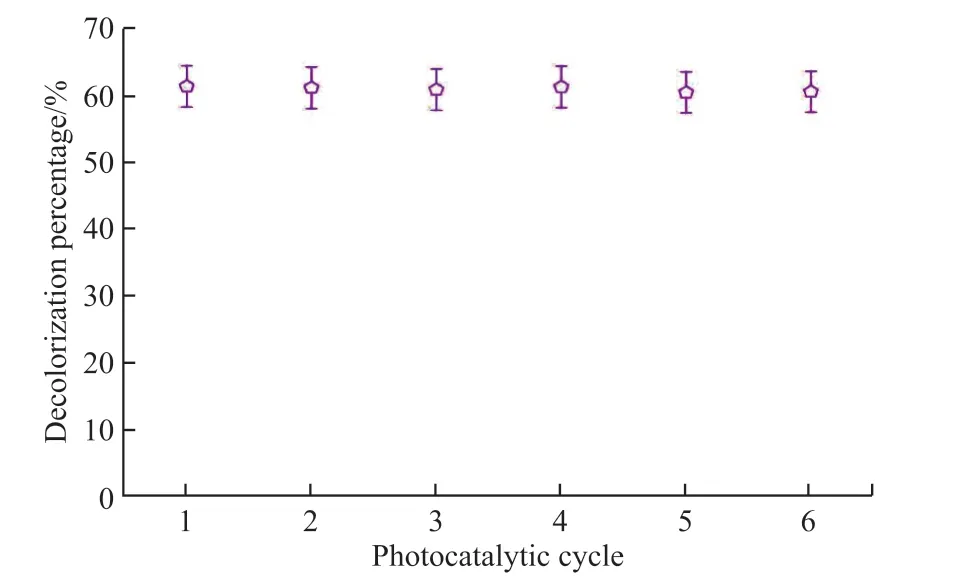
Fig.8 Photocatalytic activity of the Nd:TiO2 coating formed for 20 min of PEO treatment under the current density of 250 mA/cm2 (The coating was exposed to 180 min simulated sunlight irradiation in each turn)
To comprehensively investigate the effect of Nd2O3on photocatalytic properties of Nd:TiO2coatings, the Nd2O3was added into phosphatebased electrolyte with different concentration.The concentration of Nd2O3was added from 4 to 12 g/L with 2 g/L interval.The results were showed in Fig.9.It can be seen that the photocatalytic decolorization percentage of Nd:TiO2coatings increased with the increasing Nd2O3concentration during the whole 180 min photocatalytic irradiation.This directly proved that the photocatalytic activity of Nd:TiO2coatings can increase with the increasing Nd2O3concentration.On the other hand, in Fig.9, it can be seen that the Nd:TiO2coatings formed in 8, 10 and 12 g/L Nd2O3-containing electrolyte, was almost of the same photocatalytic decoloization percentage over 180 min photocatalytic irradiation.At the Nd2O3concentration of 4 and 6 g/L, the photocatalytic decolorization Nd:TiO2coatings was lower than others after 180 min photocatalytic irradiation.This indicated that the Nd2O3is of ability to improve the photocatalytic activity of Nd:TiO2coatings on some extent.With the continuous increment of Nd2O3, the effect seems to be faint.

Fig.9 Photocatalytic decolorization percentage of Nd:TiO2 coating formed in 12 g/L Na3PO4 solution with different concentration of Nd2O3 for 20 min PEO treatment with the current density of 250 mA/cm2 in MB solution after different time of simulated sunlight irradiation
The mechanisms for the Nd:TiO2coating used as photocatalyst in photocatalytic reaction with the MB solution could be summarized as following.The schematic model for the photocatalytic process is showed in Fig.10.During the PEO process, the electrolyte composition reacts with the coatings.The Nd3+comes from the Nd2O3-containing electrolyte disturbs the CB or VB (or both of them), which leads to the states in the band gap of TiO2that absorb visible light[17].During the photocatalytic process, the Nd:TiO2coating was exposed to the simulated sunlight with no covering, and this process would create an electron from the VB (valence band) to the CB (conduction band) and create a hole in the VB.In this investigation,the absorption edges shift toward longer wavelengths for the Nd/TiO2, which is owing to the fact that the electronic transition comes from the doped energy level to the CB of TiO2.Nevertheless, there exists a possibility that an electron comes from the VB of Nd/TiO2to the CB of Nd/TiO2.And this process needs less energy than that of the excitation of electrons from the VB energy of the anatase.The electron and hole carriers may migrate to the surface and react with the adsorbed-molecular oxidation/reduction reactants in the desired process, or they may undergo the undesired recombination process.
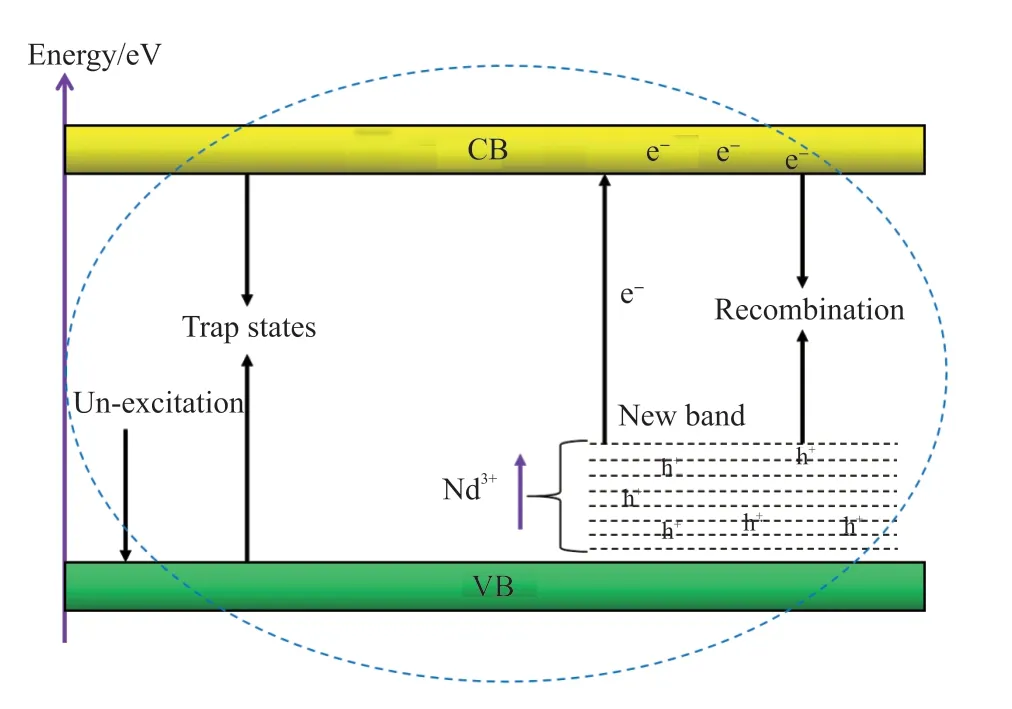
Fig.10 Schematic illustration of new band formation in Nd:TiO2 PEO coating
4 Conclusions
Nd:TiO2coatings were formed in phosphatebased electrolyte with the addition of Nd2O3by PEO technology on pure titanium with different current density.Morphology, composition, element,photocatalytic activity of the coatings were studied by various method.The conclusions can be drawn as follows:
a) The micropores decreased on quantity and increased on scale with the increasing current density.The roughness of coatings increased with increment of current density.
b) The coating was mainly composed of anatase and rutile.And the content of anatase first increased and then decreased with the increasing current density.
c) Ti2p spin-orbit components of Nd:TiO2coatings shifted towards higher binding energy, with respect to pure TiO2coating, suggesting that some of the Nd3+ions caused TiO2lattice distortion.
d) Nd:TiO2coatings present a more superior photocatalytic activity than that of pure TiO2coatings.The photocatalytic decolorization percentage increased about 20.1 % for the Nd:TiO2coating treated with current density of 150 mA/cm2than that of the pure TiO2coating.
e) The PEO treatment parameter current density is an important factor that affects photocatalytic activity and the Nd:TiO2coating formed in the phosphatebased electrolyte with the applied current density of 250 mA/cm2through PEO treatment showed the most superior photocatalytic activity.And the photocatalytic decolorization percentage for the one treated with current density of 250 mA/cm2increased about 26 %than that of the one treated with current density of 150 mA/cm2.
Conflict of interest
All authors declare that there are no competing interests.
 Journal of Wuhan University of Technology(Materials Science Edition)2024年1期
Journal of Wuhan University of Technology(Materials Science Edition)2024年1期
- Journal of Wuhan University of Technology(Materials Science Edition)的其它文章
- Effect of VEGF/GREDVY Modified Surface on Vascular Cells Behavior
- Evolution of Biofilm and Its Effect on Microstructure of Mortar Surfaces in Simulated Seawater
- Synthesis of Organic-Inorganic Hybrid Aluminum Hypophosphite Microspheres Flame Retardant and Its Flame Retardant Research on Thermoplastic Polyurethane
- Surface Metallization of Glass Fiber (GF) /Polyetheretherketone (PEEK) Composite with Cu Coatings Deposited by Magnetron Sputtering and Electroplating
- Effect of Size Change on Mechanical Properties ofMonolayer Arsenene
- Effects of Sinusoidal Vibration of Crystallization Roller on Composite Microstructure of Ti/Al Laminated Composites by Twin-Roll Casting
